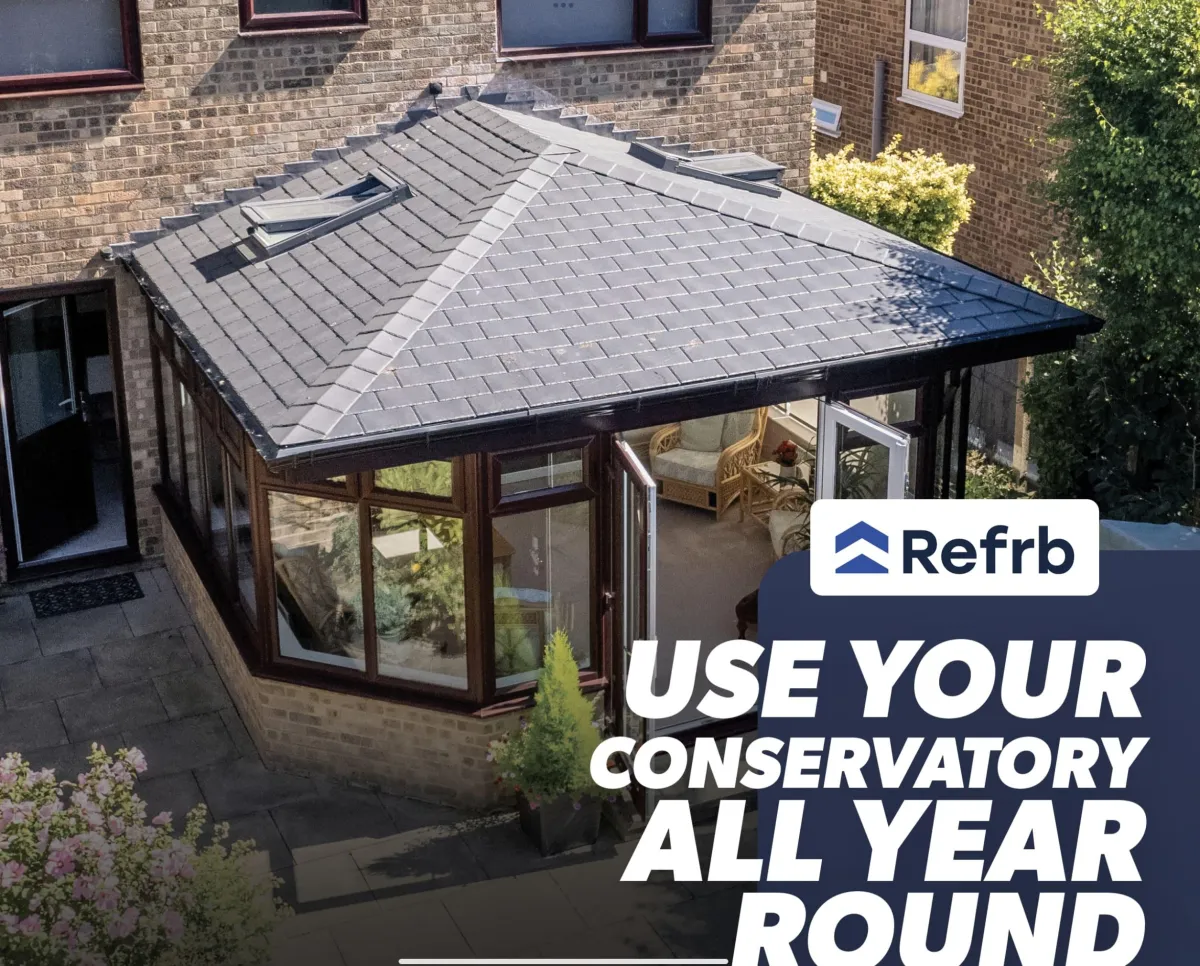
The Pros And Cons Of Insulating Your Conservatory
Monday 19th December by myrefurb

Your cosy conservatory oasis is a few clicks away...
For homeowners in the UK, conservatories became a building staple during the 1980s. The glass retreats offered a naturally lit, cozy space for quiet breakfasts and evening reads. In an ideal world, a conservatory is a separate room built to enjoy a tranquil, sunny atmosphere all year round.
However, as many conservatory owners soon discovered, the original models lacked one essential component: insulation. Thanks to the nature of all glass windows and ceilings, summer turned the quaint extensions into sweltering saunas, and heat evaporated through the roofs during the cold winters. Factor in noisy windstorms, rain, or hail, and the room becomes uninhabitable at any time of the year.
Thankfully, we can rekindle our dreams of the serene sunlight escape with multiple advances in modern roofing and insulation technology. Now the question is, is insulating your conservatory right for you? Let’s review the pros and cons of conservatory insulation.
The Benefits of Insulating Your Conservatory
Stable Temperatures
The biggest argument for conservatory insulation is temperature control. Without insulation, nearly 80% of heat enters through the conservatory glass roof, and 90% escapes—making for uncomfortably hot summers and freezing winters. Insulation helps stop the thermal gain from sunlight hitting your roof in the summer and reduces heat loss from 90% to 10% during the winter. Steady temperatures become a new reality from day one of installation.
Multiple options for use
When you look at your conservatory, how do you imagine it? A personal book nook with a glass of your favorite wine? An office to use for work? Maybe a playroom for the kids? One of the best parts about having a conservatory is the sheer number of possibilities for its space. Whether it’s intended for entertaining, dining, or strictly office use, choosing a final purpose can help the roofing contractor decide your insulation needs.
Less expensive than an extension
Over the last three years of the pandemic, many homeowners have weighed the possibility of adding an extension to create an additional office space for remote workers. An insulated conservatory can serve as the perfect condition for work-at-home requirements at a fraction of the cost. Average extension projects cost approximately £1,500-£2,500 per meter squared, compared to an average of £500-700 per meter squared for tiled roof conservatories.
For home extensions, there’s also a higher chance of unforeseen factors leading to extra costs outside the budget, such as plumbing or electricity issues. Additionally, updating your conservatory is less disruptive to your current living arrangements, as the process typically takes one to five days to complete compared to the seven to fifteen months an extension requires.
Adds Value to Your Home
Adding insulation to your conservatory is more than just a cost; it’s an investment in your overall property value. According to Gov.uk, the average property price is £281,161 as of March 2022. A well-built conservatory can increase the value of your home by five to seven percent. On the high side, that’s an increase of nearly £20,000. Even if the insulation costs £15,000, that’s a net profit of £5,000. That’s in addition to the money you’ll save on heating and air from adding the insulation.
Going Green
Adding insulation to your conservatory is more than just a cost; it’s an investment in your overall property value. According to Gov.uk, the average property price is £281,161 as of March 2022. A well-built conservatory can increase the value of your home by five to seven percent. On the high side, that’s an increase of nearly £20,000. Even if the insulation costs £15,000, that’s a net profit of £5,000. That’s in addition to the money you’ll save on heating and air from adding the insulation.
Downsides of Insulating Your Conservatory
Not for Every Conservatory
Depending on your conservatory, insulation panels may not meet building regulations due to excess weight overloading current support footings. Even if your conservatory does meet compliance regulations, the lack of venting may result in condensation and mold growth over time. For example, polycarbonate conservatory roofs tend to leak more than other materials. Your conservatory may require an entirely new roof, which can be more expensive than an insulation job.
Building Regulations and Planning Permissions
For all large-scale home improvement projects, building regulations and planning permissions can be two of the most challenging topics. Generally, conservatory refurbishment projects are exempt from planning permissions—the measurements and details of which can be found on the Planning Portal. Next is to find out if it meets building regulations, also available on the Planning Portal. Meeting both requirements could potentially require a lot of paperwork. However, more experienced roofing companies are willing to handle the entire process on your behalf.
Timing
For all large-scale home improvement projects, building regulations and planning permissions can be two of the most challenging topics. Generally, conservatory refurbishment projects are exempt from planning permissions—the measurements and details of which can be found on the Planning Portal. Next is to find out if it meets building regulations, also available on the Planning Portal. Meeting both requirements could potentially require a lot of paperwork. However, more experienced roofing companies are willing to handle the entire process on your behalf.
Choosing a Professional
When it comes to hiring a professional for any job, typing your query into Google and choosing the first result isn’t enough anymore. As we mentioned before, the average price for tiled roof conservatories is between £500-700 per square meter, peaking at around £1000 per square meter for more complex jobs. Unfortunately, several national companies offer enormous “same-day discounts” on exorbitant prices should the homeowner agree to their sales pitch.
Knowing the average costs and taking the time to research companies can feel like an onerous burden. A few factors to consider beyond the price are the type and quality of roof each vendor installs, the amount of time the transformation will take, and what past clients have to say.
Conclusion
If, after reading this article, you still need help deciding whether insulating and converting your conservatory into your personal grotto is right for you, we’re happy to help! Right now, you can receive a free, instant conservatory quote in 30 seconds—without having to speak with a representative. We proudly partner with the best home improvement companies across the UK, and we look forward to working with you!
Your cosy conservatory oasis is a few clicks away...
For homeowners in the UK, conservatories became a building staple during the 1980s. The glass retreats offered a naturally lit, cozy space for quiet breakfasts and evening reads. In an ideal world, a conservatory is a separate room built to enjoy a tranquil, sunny atmosphere all year round.
However, as many conservatory owners soon discovered, the original models lacked one essential component: insulation. Thanks to the nature of all glass windows and ceilings, summer turned the quaint extensions into sweltering saunas, and heat evaporated through the roofs during the cold winters. Factor in noisy windstorms, rain, or hail, and the room becomes uninhabitable at any time of the year.
Thankfully, we can rekindle our dreams of the serene sunlight escape with multiple advances in modern roofing and insulation technology. Now the question is, is insulating your conservatory right for you? Let’s review the pros and cons of conservatory insulation.
The Benefits of Insulating Your Conservatory
Stable Temperatures
The biggest argument for conservatory insulation is temperature control. Without insulation, nearly 80% of heat enters through the conservatory glass roof, and 90% escapes—making for uncomfortably hot summers and freezing winters. Insulation helps stop the thermal gain from sunlight hitting your roof in the summer and reduces heat loss from 90% to 10% during the winter. Steady temperatures become a new reality from day one of installation.
Multiple options for use
When you look at your conservatory, how do you imagine it? A personal book nook with a glass of your favorite wine? An office to use for work? Maybe a playroom for the kids? One of the best parts about having a conservatory is the sheer number of possibilities for its space. Whether it’s intended for entertaining, dining, or strictly office use, choosing a final purpose can help the roofing contractor decide your insulation needs.
Less expensive than an extension
Over the last three years of the pandemic, many homeowners have weighed the possibility of adding an extension to create an additional office space for remote workers. An insulated conservatory can serve as the perfect condition for work-at-home requirements at a fraction of the cost. Average extension projects cost approximately £1,500-£2,500 per meter squared, compared to an average of £500-700 per meter squared for tiled roof conservatories.
For home extensions, there’s also a higher chance of unforeseen factors leading to extra costs outside the budget, such as plumbing or electricity issues. Additionally, updating your conservatory is less disruptive to your current living arrangements, as the process typically takes one to five days to complete compared to the seven to fifteen months an extension requires.
Adds Value to Your Home
Adding insulation to your conservatory is more than just a cost; it’s an investment in your overall property value. According to Gov.uk, the average property price is £281,161 as of March 2022. A well-built conservatory can increase the value of your home by five to seven percent. On the high side, that’s an increase of nearly £20,000. Even if the insulation costs £15,000, that’s a net profit of £5,000. That’s in addition to the money you’ll save on heating and air from adding the insulation.
Going Green
Adding insulation to your conservatory is more than just a cost; it’s an investment in your overall property value. According to Gov.uk, the average property price is £281,161 as of March 2022. A well-built conservatory can increase the value of your home by five to seven percent. On the high side, that’s an increase of nearly £20,000. Even if the insulation costs £15,000, that’s a net profit of £5,000. That’s in addition to the money you’ll save on heating and air from adding the insulation.
Downsides of Insulating Your Conservatory
Not for Every Conservatory
Depending on your conservatory, insulation panels may not meet building regulations due to excess weight overloading current support footings. Even if your conservatory does meet compliance regulations, the lack of venting may result in condensation and mold growth over time. For example, polycarbonate conservatory roofs tend to leak more than other materials. Your conservatory may require an entirely new roof, which can be more expensive than an insulation job.
Building Regulations and Planning Permissions
For all large-scale home improvement projects, building regulations and planning permissions can be two of the most challenging topics. Generally, conservatory refurbishment projects are exempt from planning permissions—the measurements and details of which can be found on the Planning Portal. Next is to find out if it meets building regulations, also available on the Planning Portal. Meeting both requirements could potentially require a lot of paperwork. However, more experienced roofing companies are willing to handle the entire process on your behalf.
Timing
For all large-scale home improvement projects, building regulations and planning permissions can be two of the most challenging topics. Generally, conservatory refurbishment projects are exempt from planning permissions—the measurements and details of which can be found on the Planning Portal. Next is to find out if it meets building regulations, also available on the Planning Portal. Meeting both requirements could potentially require a lot of paperwork. However, more experienced roofing companies are willing to handle the entire process on your behalf.
Choosing a Professional
When it comes to hiring a professional for any job, typing your query into Google and choosing the first result isn’t enough anymore. As we mentioned before, the average price for tiled roof conservatories is between £500-700 per square meter, peaking at around £1000 per square meter for more complex jobs. Unfortunately, several national companies offer enormous “same-day discounts” on exorbitant prices should the homeowner agree to their sales pitch.
Knowing the average costs and taking the time to research companies can feel like an onerous burden. A few factors to consider beyond the price are the type and quality of roof each vendor installs, the amount of time the transformation will take, and what past clients have to say.
Conclusion
If, after reading this article, you still need help deciding whether insulating and converting your conservatory into your personal grotto is right for you, we’re happy to help! Right now, you can receive a free, instant conservatory quote in 30 seconds—without having to speak with a representative. We proudly partner with the best home improvement companies across the UK, and we look forward to working with you!
2022 Use Growth LTD trading as myrefurb. All rights reserved.
Terms & Conditions
Privacy Policy


